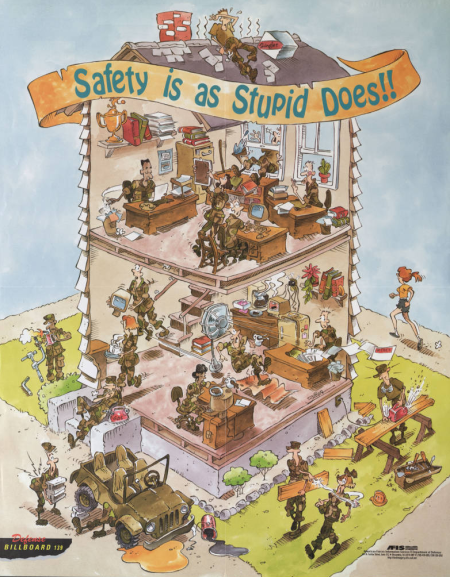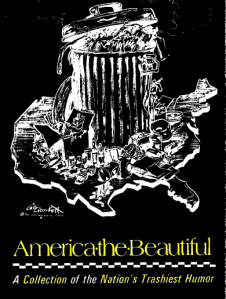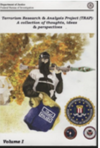A few weeks ago, Jennifer Davis’ supervisor delivered a challenge to her via email: write a story about humorous government document titles for April Fool’s Day. (Read various stories about the origins of April Fool’s Day here, here and here.) April Fool’s humor has had a long history with American Government, dating back to Founding Father Benjamin Franklin (read caption below).

According to news humor site “Weekly World News”, the American founding father of April Fool’s Day was Benjamin Franklin. Since Franklin, April 1st has been synonymous in America for a day of practical jokes and general mischief. Tales of his exploits were published in the Philadelphia Gazette on the 1st of April every year. For example, says the site, he was known to give entire public speeches on April 1 wearing an ostentatious fake moustache. 😉 Can you believe it? (Image courtesy of Weekly World News.)- M. Bartram
Says Jennifer: “I love reading government documents for their data and their fascinating stories, but I usually wouldn’t consider them to be laugh-out-loud funny. Or as a colleague said, “They’re not Abbott and Costello funny”. But everyone’s got to laugh some time, right? And when I searched GPO’s Catalog of U.S. Government Publications (CGP), and picked my colleagues’ brains, I found that Uncle Sam sometimes gets his chuckles, too. I found more titles than these ten—but I want to save some for another occasion. There have been a few other lists of humorous government documents, not all of them Federal titles, circulating around the Internet, and so I’ve tried to keep this list as unique as possible.”
(If you like the topic of this column, you should visit the Washington State University’s exhibit, The Lighter Side of…. The Government Printing Office, which runs through June 28, 2014.)
[Michele Bartram Editor’s Note: Over the years, Government Book Talk has also highlighted some funny Federal publication titles within previous blog posts including: Society through a Comic Lens, The Nuttall Tick Catalogue, Dr. Seuss, U.S. Army, Sprocket Man!, War Games, and Ponzimonium. You’ll chuckle over the odd, quirky, ironic or inadvertently funny titles of the books mentioned!]
All of these titles in this blog post have records in GPO’s Catalog of U.S. Government Publications, and you might be able to find a copy in your local Federal depository library, or find one at your regional library. Click here for a list of Federal Depository Libraries (the Federal Depository Library Directory or FDLD). Since many of these Government documents —books, posters, pamphlets and PDFs— are older than five years, you might have to search a bit to find a copy. When available, we have provided links for the electronic version of these titles.
Below is the list of Top 10 funniest titles that Jennifer provided, along with additional details about each.
TOP 10 FUNNIEST TITLES
 1) Gobbledygook has Gotta Go. This Bureau of Land Management title about the problems with Government writing is a classic, and a precursor to the “Plain Language” initiative today to simplify the wording in communications. It has been cited in several collected lists of funny titles, and it’s the only time I cheated and included it in my list anyway. Gobbledygook is just such a great word to say, and the alliteration makes the title even funnier. You can read a scanned copy of this book here.
1) Gobbledygook has Gotta Go. This Bureau of Land Management title about the problems with Government writing is a classic, and a precursor to the “Plain Language” initiative today to simplify the wording in communications. It has been cited in several collected lists of funny titles, and it’s the only time I cheated and included it in my list anyway. Gobbledygook is just such a great word to say, and the alliteration makes the title even funnier. You can read a scanned copy of this book here.
2) Preparedness 101: Zombie Pandemic. All of our GPO office mates agree: this comic has got to be the most fun Federal government document to date. The CDC was smart and exploited the current interest in zombies, and made an emergency preparedness checklist into a comic on preparing for the “zombie pandemic”. In this comic, the scientists of the CDC are the superheroes, isolating the virus “Z5N1” and developing a vaccine in record time, while the locals develop a checklist of emergency supplies so they can stay inside their home. Just the title alone is enough to make you smile—and it gets its point across. You can read the entire publication online here.
3) This is a Dumb Bunny. I love the idea of the Federal government calling someone a “dumb bunny”. Even if the document it is quite literally the image of a rabbit, which spoils some of the fun, I am still tickled by the idea of a snarky Uncle Sam. The poster’s actually about smoking cessation.
4) Safety is as Stupid Does!! I know what the goal was with this title. The poster (seen on the University of Iowa Digital Library) makes it clear to the intended audience of military personnel that not thinking hurts safety on the job. However, I think the title missed the mark. It’s funny in its own right.

5) Do Mandrakes Really Scream? A colleague of mine is a huge Harry Potter fan. She said cataloging this title was the pinnacle of her career. It’s the online exhibition catalog of an National Library of Medicine (NLM) History of Medicine exhibit relating NLM’s historical holdings and the magic and medicine of Harry Potter.
If you read the Harry Potter series, you’ll know what the title is referring to. If you haven’t read the series, check out this free exhibit first; you might find yourself diving into the book series afterwards.
6) USDA Saves French Donkey. The title of this mid-1980s US Department of Agriculture publication just speaks for itself.
[Editor’s note: Probably the publication refers to this 1985 story reported in the Los Angeles Times about a rare 7-month-old curly haired French Poitou donkey named Sonette at the San Diego Zoo: “Rare Donkey Passes Test, Can Stay Here”]

The rare French Baudet du Poitou donkey breed is born with curly hair that naturally grows into long dreadlocks as an adult. This one hasn’t had a haircut in 17 years! (Source: The Telegraph – UK)
7) Self-Motion Perception and Motion Sickness: Final Report for the Project NASA’s report on a motion sickness project makes me want to just… stop… moving! Read about it on NASA’s website.
 Above: NASA astronauts in zero gravity try to fend off the effects of motion sickness. To learn more about motion sickness, watch this 3-minute TED Talk animated video about “The Mystery of Motion Sickness.”
Above: NASA astronauts in zero gravity try to fend off the effects of motion sickness. To learn more about motion sickness, watch this 3-minute TED Talk animated video about “The Mystery of Motion Sickness.”
 8) America the Beautiful: Collection of the Nation’s Trashiest Humor. Not only is the title funny, but the book’s content promises humor as well. This is publication number 2048 of The U.S. Department of Health, Education, and Welfare, originally published in 1970. The book consists of thirty comics, from the funny pages like B.C., and some from the editorial pages of publications from the New Yorker to the Cleveland Plain Dealer, all focusing on the problem of waste disposal. You can read the publication in its entirety online at the EPA’s website.
8) America the Beautiful: Collection of the Nation’s Trashiest Humor. Not only is the title funny, but the book’s content promises humor as well. This is publication number 2048 of The U.S. Department of Health, Education, and Welfare, originally published in 1970. The book consists of thirty comics, from the funny pages like B.C., and some from the editorial pages of publications from the New Yorker to the Cleveland Plain Dealer, all focusing on the problem of waste disposal. You can read the publication in its entirety online at the EPA’s website.
9) French Meadows: Hell Hole Recreation Areas. Although the area is really quite lovely, there’s a problem with image marketing in this U.S. Forest Service tourism brochure.
 10) Controlling Vampire Bats. This serious US Agency for International Development publication about controlling the spread of rabies through these creatures nevertheless evokes shades of Tippi Hedren… Don’t you get a mental picture of people running down the street away from the bats, waving their arms over their heads and screaming, à la The Birds? Or Fay Wray being controlled by an evil vampire in bat form in the movie “The Vampire Bat” (movie poster image at the right)? Maybe I’ve read too many zombie comics.
10) Controlling Vampire Bats. This serious US Agency for International Development publication about controlling the spread of rabies through these creatures nevertheless evokes shades of Tippi Hedren… Don’t you get a mental picture of people running down the street away from the bats, waving their arms over their heads and screaming, à la The Birds? Or Fay Wray being controlled by an evil vampire in bat form in the movie “The Vampire Bat” (movie poster image at the right)? Maybe I’ve read too many zombie comics.
How can I find these funny-titled Federal publications?
In addition to clicking on the links in the article above to find the publications, you may find these publications from the following:
- Visit a Federal Depository Library: Search for U.S. Government publications in a nearby Federal depository library.
- Librarians: You can find the records for most titles in the Catalog of U.S. Government Publications (CGP), or search for published U.S. Government eBooks in GPO’s Federal Depository Library Program’s special eBooks at GPO page.
- Visit a Public Library: Ask your local public librarian about Federal Government books available to check out as well as Federal eBooks that may be available for library patrons to digitally download through the library’s Overdrive subscription.
And to find popular current Federal publications, you may:
- Shop Online Anytime: You can buy eBooks as well as print publications (with FREE Standard Shipping worldwide) from the U.S. Government Online Bookstore website at http://bookstore.gpo.gov
- Order by Phone: You may also Order print editions by calling GPO’s Customer Contact Center Monday through Friday, 8 am to 5:30 pm Eastern (except US Federal holidays). From US and Canada, call toll-free 1.866.512.1800. DC or International customers call +1.202.512.1800.
- Shop our Retail Store: Buy a copy of any print editions at GPO’s retail bookstore at 710 North Capitol Street NW, Washington, DC 20401, open Monday–Friday, 9 a.m. to 4 p.m., except Federal holidays, Call (202) 512-0132 for information or to arrange in-store pick-up.
About the author: Adapted and expanded by Michele Bartram, Government Book Talk Editor and Promotions Manager for GPO’s Publication and Information Sales Division in Washington, DC, from an original post by Jennifer K. Davis, formerly from GPO’s Library Services & Content Management Division that supports the Federal Depository Libraries Program (FDLP).
Have a fun and funny April Fool’s Day!







 Posted by Michele Bartram, U.S. Government Online Bookstore
Posted by Michele Bartram, U.S. Government Online Bookstore 














